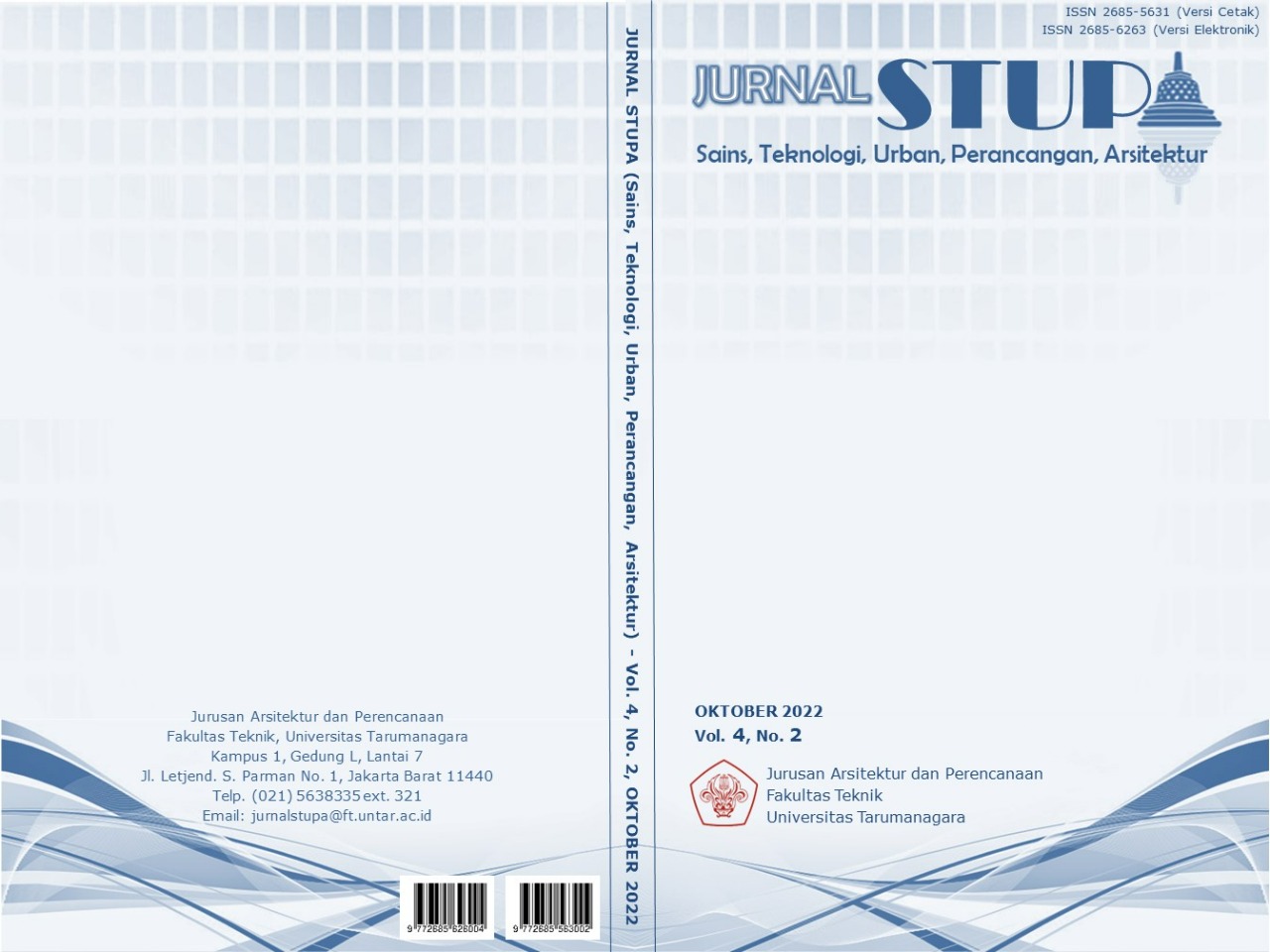RUANG SENI SENEN SEBAGAI TITIK AKUPUNKTUR PERKOTAAN UNTUK MENGHIDUPKAN IDENTITAS KESENIAN DAN MEMORI SENEN
Main Article Content
Abstract
The Senen area was formerly known as the center for arts and cultural action in Jakarta. Then it became a hangout place for artists known as Seniman Senen. In 1968, the Governor of Jakarta decided to build Taman Ismail Marzuki which was expected to become a new art center in Jakarta. But slowly the big name of Seniman Senen dimmed when political agitation among artists began to strengthen. Senen began to lose the essence of art along with the times that faded the local culture. Meanwhile, the Senen area, which has been revitalized several times, still has a point of degradation. One of them is the Grand Theater, a historic film show building that was abandoned because it was unable to compete with the currents of globalization. The Grand Theater was burned by mass demonstrations against the policy of the Onimbus Law, which finally entered a phase of stagnation for six years and damaged the image of the Senen area. It is at this point that urban acupuncture can work to revive the Grand Theater, supported by narrative and experimental methods. It is hoped that it can awaken the art of film, create an art platform, and an artistic path that can strengthen the identity and memory of the area as the center of art in Jakarta. It is also hoped that it can be input and produce the right forum for the Senen community in developing arts, culture, as well as restoring the image of the region in the midst of globalization. This project changes the concept of art into a newer one based on collective memory so that it can be relevant to people's lives today and in the future.
Keywords: Degradation; Grand Theater; Senen Art; Urban Acupuncture
Abstrak
Kawasan Senen dahulu dikenal sebagai pusat aksi kesenian dan kebudayaan di Jakarta. Kemudian sempat menjadi tempat kongko seniman yang dikenal sebagai Seniman Senen. Pada 1968, Gubernur Jakarta memutuskan untuk membangun Taman Ismail Marzuki yang diharapkan menjadi pusat seni baru di Jakarta. Tetapi perlahan nama besar Seniman Senen meredup ketika agitasi politik di kalangan seniman mulai menguat. Senen mulai kehilangan esensi seni seiring dengan perkembangan zaman yang memudarkan budaya lokal. Sementara itu, Kawasan Senen yang sudah beberapa kali direvitalisasi ternyata masih memiliki titik degradasi. Salah satunya Grand Theater, bangunan pertunjukan film bersejarah yang terbengkalai karena kalah bersaing digerus arus globalisasi. Grand Theater sempat terbakar oleh unjuk masa yang menolak kebijakan UU Onimbus Law akhirnya memasuki fase stagnansi selama enam tahun dan merusak citra kawasan Senen. Pada titik inilah akupunktur perkotaan dapat bekerja untuk menghidupkan kembali Grand Theater, didukung dengan metode narasi dan eksperimental. Diharapkan dapat membangkitkan seni perfilman, menciptakan wadah seni, dan jalur seni yang mampu memperkuat identitas juga memori kawasan sebagai pusat kesenian di Jakarta. Diharapkan pula dapat menjadi masukan dan menghasilkan wadah yang tepat untuk masyarakat Senen dalam pengembangan kesenian, kebudayaan, juga mengembalikan citra kawasan ditengah arus globalisasi. Proyek ini mengubah konsep seni menjadi lebih baru berdasarkan memori kolektif agar dapat relevan dengan kehidupan masyarakat saat ini dan masa depan.
Article Details

This work is licensed under a Creative Commons Attribution-NonCommercial-ShareAlike 4.0 International License.
This work is licensed under a Jurnal Sains, Teknologi, Urban, Perancangan, Arsitektur/ STUPA Creative Commons Attribution-NonCommercial-ShareAlike 4.0 International LicenseReferences
__ (2009). Berkesenian Peringati Setahun Komunitas Planet Senen. Kompas.com. Diakses pada 9 Februari 2022, dari https://lifestyle.kompas.com/read/2009/04/26/18192417/~Oase~Cakrawala?page=all
Ahmad. (2021). Pengertian Seni. Yuksinau.id. Diakses pada 11 Februari 2022, dari https://www.yuksinau.id/pengertian seni/#Pengertian_Seni_Menurut_Para_Ahli
Apostolou, M. (2018). Urban eco-acupuncture methods: case study in the city of Athens. 2nd International Conference on Changing Cities II: Spatial, Design, Landscape & Socio-economic Dimensions Porto Heli, Greece.
Biran, M. Y. (2008). Keajaiban di Pasar Senen. Jakarta: Gramedia.
Casagrande, M. (2015). Paracity: Urban Acupuncture. Public Spaces Bratislava: International Conference.
Coates, N. (2012). Architectural Digest: Narrative Architecture. Oxford: Wiley.
Koentjaraningrat. (1989). Kebudayaan, Mentalitas, dan Pembangunan. Jakarta: Gramedia.
Lerner, J. (2014). Urban acupuncture. Washington, DC: Island Press.
Ryan, C. (2013). Eco-Acupuncture: Designing and facilitating pathways for urban transformation, for a resilient low-carbon future. Journal of Cleaner Production.
Salim, H. (2018). tHEORY 101: Aldo Rossi’s Collective Memory. Arch.ive. Diakses pada 11 Februari 2022, dari https://medium.com/@heryantosalim/theory-101-aldo-rossis-collective-memory-1caa3e006069
Sutanto, A. (2020). Peta Metode Desain. Jakarta.
Tylor, E. B. (1871). Primitive Culture: Researches Into the Development of Mythology, Philosophy, Religion, Art, and Custom, Volume 1. London: John Murray Publisher.



